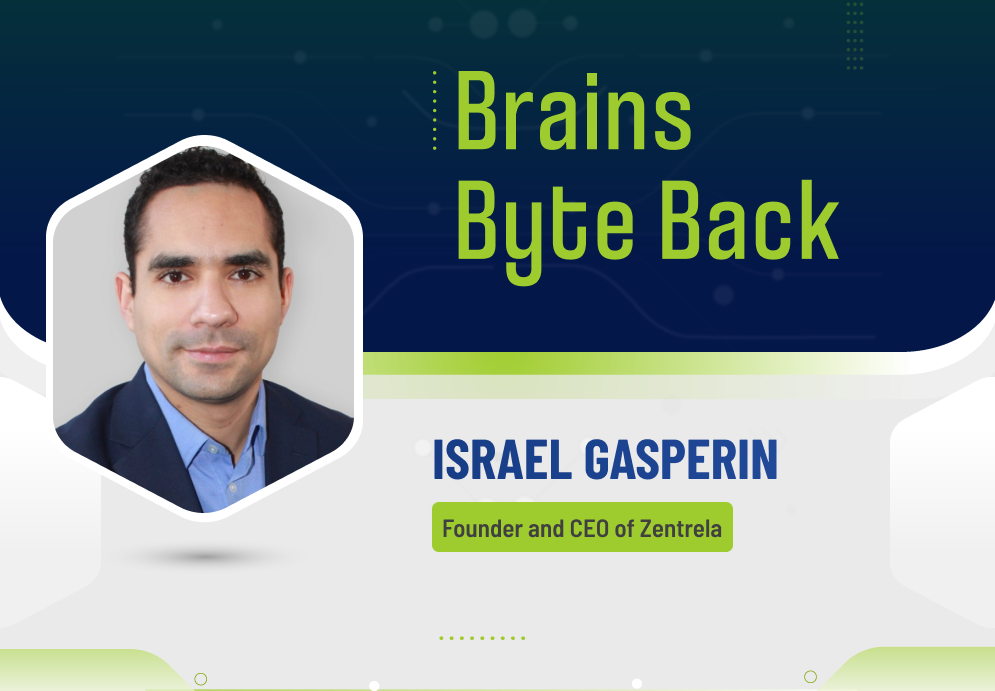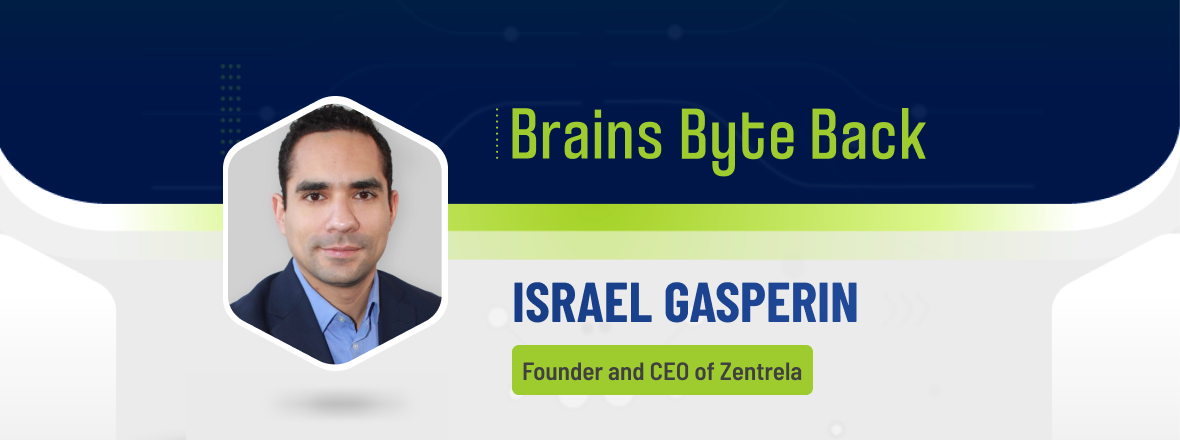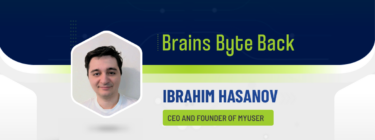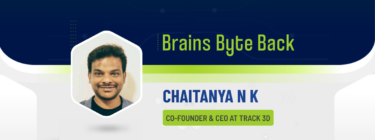In this episode of Brains Byte Back, Israel Gasperin, founder and CEO of Zentrela, joins the podcast to discuss his neurotechnology company and its pioneering use of artificial intelligence (AI) to analyze brainwaves. Gasperin explains how traditional drug tests can’t measure cognitive impairment in a way that’s beneficial to consumers or sellers, leading his team to develop an AI-based EEG (electroencephalogram) tool capable of objectively identifying impairment.
Israel, who arrived in Canada from Mexico 10 years ago to study EEG technology, explains that he’s always had a fascination with how the brain works. It just so happens that Artificial Intelligence was developing in a way that was both accessible and eye-opening during his studies. He quickly viewed it as a tool that could potentially analyze brain waves in a way we never could. In 2014, he began leveraging the technology to analyze fatigue for drivers in the trucking industry with the goal of preventing future accidents.
By 2016, he shifted gears at a time when Canada was on its way to legalizing cannabis across the country — discovering a niche that would be in demand. Between 2016 and 2018, Zentrela gathered EEG data from cannabis users and developed its AI technology, gaining critical funding from the Ontario government, supporting and reinforcing his forward-thinking use of AI. They eventually proved the technology’s efficacy, publishing peer-reviewed papers that demonstrated its ability to detect cannabis impairment with high accuracy. However, due to regulatory complexities, Zentrela pivoted toward the commercial research space, helping companies in the cannabis industry and other wellness sectors test products’ psychoactive and non-psychoactive effects.
Zentrela’s technology is now used globally, offering a faster and more cost-effective way to conduct human trials on products like cannabis, energy drinks, and wellness products. Gasperin highlights the future vision of mapping the brain’s mental states for various industries using this forward-thinking technology, helping consumers and health professionals optimize product usage.
You can listen to the full episode below, or on Spotify, Anchor, Apple Podcasts, Breaker,, Google Podcasts, Stitcher, Overcast, Listen Notes, PodBean, and Radio Public.
Find out more about Israel Gasperin here.
Find out more about Zentrela here.
Connect with Brains Byte Back host Erick Espinosa here.
TRANSCRIPT
Israel Gasperin:
My name is Israel Gasparin. I am an engineering scientist, Founder, CEO of Zentrela. Basically, we are a neurotechnology company analyzing brainwaves in a completely different approach than the traditional one, which is using clinicians. In our case, we are using artificial intelligence, and I’m happy to tell you more about it.
Erick Espinosa:
Amazing, Israel. Thank you so much for joining us on this episode of Brains Byte Back. It’s great to have a fellow Canadian on the show. I think this is the first time I’ve had a Canadian guest, and it’s relevant to mention that Canadian connection, because Zentrela from what I’ve discovered, it was kind of developed a few years prior to the historic legalization of cannabis in the great white north. Which I think we’re coming up to, what like six years now? Because it was in 2018. Which feels a lot longer, I don’t know why. Why don’t you talk to us a little bit about the lead-up during that time, 2016, which actually developed, I guess, the concept behind Zentrela.
Israel Gasperin:
Absolutely, Erick. You know, in a nutshell, I am originally from Mexico. 10 years ago, I made a plan to come to Canada and into a master’s in entrepreneurship to start playing with this type of wearable, EEG technology that reads brain waves. I have always been fascinated with the brain and how it works, and it was a beautiful time, because the emergence of artificial intelligence and machine learning was happening in this space. The application of AI to analyze EEG data for multiple applications. So we were one of the pioneers.
The original idea back in 2014 and 2016, was to use artificial intelligence to analyze brain waves and the detect how drowsy or fatigue a driver was in order to prevent mistakes or accidents, you know, while driving. I did my masters in entrepreneurship at McMaster with that project, and after graduation, I just fully dedicated my time to interview truck drivers, transportation companies, insurance companies and drug testing companies, because I wanted to understand what was the issue with driver fatigue. And all of them were telling me we are not interested. Everyone knows that drivers are tired and leaving that actually some evidence doesn’t really, really help the the industry, because, you know, driver, like drivers are paid by distance driven, etc, etc.
However, if you can detect if a person is cannabis impaired, with that wearable device on your head, that would be very interesting for us for two reasons. One, because none of the existing drug tests, which are based on saliva, urine, breath or blood analysis, do not detect cognitive impairment. They simply detect and quantify the concentration levels of a substance, in this case, THC, in those body fluids. But it is proven that you may have residuals, or you know, concentrations of substances like THC without being impaired anymore. So if you can detect some brainwave alterantions linked to cannabis impairment, that would be really exciting.
Right now, it was 2016, they were telling us, right now it’s not a problem, and the current drug tests do their job very well, because it’s illegal to consume the substance, but the moment it becomes legal, and the in the government is in the process of legalizing it, these will become a niche.
Erick Espinosa:
And I remember in the news specifically, one of the big stories that we were trying to cover was, how are officers going to measure…because there’s so many ways that you could ingest cannabis. You could smoke it, you could drink it, you could eat it. How would they determine that? And right now, based on the research that I did, their primary way of testing that is the saliva test.
Israel Gasperin:
Exactly, they have developed advanced needs that the saliva test to detect freezing cannabis consumption. So anyway, at that moment, I was like, this is the actual opportunity. So I closed the project related to driver fatigue detection. That was amazing, because we were failing so badly on that one. And there was no market interest for that application, but it gave us all the fundamentals and clarity in order to do again what we did before, but now with the detection of cannabis impairment. So between 2016 and 2018, I fully dedicated with my founding team to develop EEG data sets. In other words, record EEG data, or brain activity, of cannabis consumers when they were acutely high and when they were not under other kind of states. By 2018, that we were running out of, you know, capital, running out of cash. I was freaking out. And I was like, okay, maybe it’s time to go back home. The Ontario Center of Innovation launched a unique fund in order to support any innovative solution that could help the Ontario government to improve the investigation process of cannabis super driving. And at that time, I we already had a prototype. So when we introduced this concept to the government, they were like, this is fucking crazy. Not in those word exactly. Nothing like this has happened before. You know, there is no, zero evidence in the scientific literature that proves that the AI can detect cannabis impairment based on EEG analysis. Long story short, the external panel of experts that they contracted to evaluate all the applications, including ours. They told them, hey guys, yes, this sounds fucking crazy. But if you don’t fund and support this type of crazy concepts and possibilities, who else is going to do it? There will not be angel investors, you know, kind of putting their money at this very early stage of a startup. So you should do it.
They funded us and then the Ontario Brain Institute also funded us. Between 2018 and 2020, we continued investing those two years in continuing, developing and stabilizing our AI to do the EEG analysis for cannabis impairment detection. I guess you know where I’ll take a break of this story is that at the end of that two year period, we ended up contracting a clinical research organization that independently simulated the whole process. We said, this is the way you administered an EEG or brainwave test. Do it. Blind the data, and then the only way Zentral has to process the data and give you results, whether you collected the data when a person is impaired or not, and telling you how impaired they were, etc, will be through these AI based EEG analysis. And as a result of that, we published two peer reviewed papers reaching unprecedented accuracy, sensitivities, specificity, etc. And then at that point, the commercialization phase of the company started, not for safety and law enforcement, because also we understood, after having meetings with the Ontario Provincial Police, that this technology was not going to be used for safety and law enforcement initially. It’s still in the vision, but we understood that they were not going to be the early adopters.
Erick Espinosa:
So I understand at this point, obviously, you made that shift into the commercial market to keep developing your product, and you’re seeing it used elsewhere. What type of industries, I guess, outside of those selling cannabis, what type of industries are you looking at to serve with your, you know, with your studies, with your product and technology?
Israel Gasperin:
Yeah, so basically, Erick, what we found out is that law forces were not going to adopt it, because it requires more scientific evidence for them, and in general, the government, etc, they are usually not the first in adopting new technologies. We started to think and question, what could be that early entry to market. And what we found out is that there is a tremendous opportunity in the research space. When it’s about studying non-therapeutic effects of cannabis, but also any other type of wellness product, you know? But what we understood is that there was a reason why all of these cannabis companies have been commercializing their products without being able to describe the type of effects that they create. And the reason of that is because there didn’t exist a scientific and objective way of quantifying cannabis psychoactive effects. Point problem number one, but also, there didn’t exist a fast and affordable way of conducting this type of human trials. Either you do a clinical trial which is great for medical and therapeutic projects, or if you just do lot of reviews which are very unreliable and completely subjective. So the government tells producers, you can make any type of product attribute claim, as long as it’s probably true. And in order to be probably true, you need to do scientific human trials. And in order to do a scientific human trial, you need to do a clinical trial.
So what we found is that there is something very open, called observational trials that allows you to start doing this type of research for non-therapeutic purposes. After three and a half years of going back and forth with Health Canada. I don’t want to claim that we, that it’s due to us, but I think that we were one of the contributors that created awareness in Health Canada, that there is a space of non-therapeutic research that doesn’t need the clinical and the medical grade, the standards, in order to do research about psychoactive effects of cannabis, alcohol effects, mood changes, etc. Like, this is not therapeutic, and so they approved it. So getting back to the point the technology that we built has been used in the last three and a half years as a new fast, cost-effective and objective way of measuring the psychoactive and non psychoactive effects, or other type of effects of cannabis products like relaxation or energy, etc. So then licensed producers can use this type of data in order to reinvent and optimize their CPG business or consumer package good business. Now they are doing testing of new formulations very quickly, more reliably and cost effectively.
They decide which of the formulations is the most effective, and then, based on this evidence that complies with Health Canada regulations, they are using it to launch education programs for retailers or consumers in order to better understand what is the frequency of the products. And technically, that’s what we have been doing in the last three and a half years. And this year, we just entered into what we just extended our offering to other wellness solutions that are also developing products not for therapeutic purposes, but for relaxation and energy, recreational or non therapeutic purposes. So now we have expanded this to the global wellness market and it’s very exciting to see that we have found and unmet need in this specific niche.
Erick Espinosa:
I know that Canadian cannabis Act has parameters for Canadian brands to communicate product effects. At the beginning, there wasn’t really a way to measure that. Because there’s a lot of players in the market. A lot. Like you walk to a lot of corner stores, you’ll see different cannabis stores. But what is the government doing to make sure that these companies are following the regulated rules in terms of how to properly measure the effects and to the degree of how cannabis might affect your motor skills, or day to day activities?
Israel Gasperin:
Yeah, I think that Health Canada has been doing a great job here in Canada compared to other countries. Because if, for example, if you go to a cannabis store here, a legal cannabis store, it’s highly regulated. The information about the facts that you can see there. Retail employees need to follow strict training and guidelines in order to support consumers to make informed decisions objectively. So I think that they have been doing a great job in that regard. And also, I think that they have also done something very well in terms of leaving the door open to generate product effect data through a scientific research framework that they have created. And that’s the exciting part, right? Because in order to do this type of human trials, you need to submit your master research protocols to them, and they need to approve them. So, everything is very well connected and united. Obviously, nothing is perfect, and I think that there is a lot of opportunities to accelerate and speed up this process. I think that also there is a little bit of stigma, which I think is not fair. Just to disclose I am not a cannabis consumer, I am not an alcohol consumer, but I see the benefits and the negative sides of both aspects. And I think that right now, the the tendency leans towards a little bit the some negative aspects of cannabis, which today they don’t make sense. Because if the federal government has legalized this substance for recreational use, and they are making a lot of money. I think that they should help to accelerate this process. But overall, I think that they have been doing a great job.
Erick Espinosa:
I think in Canada, it’s just become so part of our culture now. That within the next 10 to 15 years, it’s just you walk down the street and you smell it, and it’s just such a normal thing. But it’s interesting to sit here and talk with you today, because I’ve made this joke with my friend in the past, where when we walk into a cannabis store, really, when you’re buying a product, it’s based on the effects. Whether or not they’re saying sativa or indica, what makes you happy, the other one makes you relaxed. That’s what determines you buying the product.
And I’ve made the joke before about, like, is it just a guy sitting in a room testing out all the products to see how he feel, he feels, and he’s, you know, like has a scorecard in front of him. But essentially, what you’re saying is that you are that guy. You are that company offering that technology to determine what the effects of those products are. So Canadians really know what they’re buying.
Israel Gasperin:
That is exactly right, Erick. We are following these scientific and objective procedures or protocols in order to characterize that type of effects and also understand, what type of effects products create depending on the amount that they are consumed, the consumption amount, and, more importantly, the type of consumer, because it’s very well known that there is a lot of human variability or human factors that, contrastingly, cause different effects. For example, gender. We don’t know necessarily if it’s gender, but we have been conducting studies with CBD, for example, CBD products. Our EEG analysis show that women react more to CBD in terms of relaxation effects, whereas, you know, men seems to be less sensitive to the same amount that women had.
Now, I’m not necessarily saying that is the gender the reason why they react differently, but it may be another fact human factor related to their gender. But the exciting part here is that, and it’s related to where I see Zentral in the future, it’s about helping. For example, helping health professionals or even the consumers to know what should be the right product in the right amount to consume in order to accomplish that desire, effect or experience. Because, basically that’s the long term vision of the company to have fully map the brain with the technology and under different mental states. So the machine learning learns how to do that type of analysis. So we can objectify, standardize and systematize brainwave analysis to let many industries do this type of mental state assessments for different purposes. So I think there are several possibilities here to change industries and markets, and we are very excited about it.
Erick Espinosa:
How early on did you realize that this would be such a fundamental technology in terms of really being successful in this type of research,
Israel Gasperin:
Literally, in 2016. Yeah, that’s why I call myself an engineering scientist. Not a scientist. I don’t have a PhD, and I have a huge respect for like everyone has who has a PhD, but in order to build a solution, I just realized that a what you needed is more an engineering and innovative approach to connect the dots. And what I was thinking in 2016 is okay, I have tried cannabis and I have been drunk as well, and I know that my brain is seeing a completely different way of working or functioning. That is fact number one. Also, I know that this type of EEG technology is reading brain activity micro bolts generated from different regions of the brain. And that’s a fact, and it has been used for more than 100 years by neurologists, neuroscientists, doctors. But it is well known that the brain functionality and this type of data generated from EEG technology is so complex that anybody in the entire world and in the history of humanity has been able to fully understand how to analyze it in a way that we can apply this device and know you are high or you are drunk or you are in pain or you are sad, etc.
But all of these researchers have shown evidence that they do a little bit of basic analysis, and there is evidence that this technology is capable of detecting that with very basic human based analysis. So then, at that point, the emergence of artificial intelligence was happening, and that was the third rationale that I applied. It is proven that AI is capable of doing complex analysis that we humans are not able to make. And so then I was like, what would it happen if we start building banks of brain data on their different mental states so we can detect when you’re high or you’re not high? At a very basic level, that was the way I envisioned this. And some neuroscientists said that this was stupid and that just gave me more, you know, the strength and motivation to say, well, maybe, but you don’t have a way to prove that this is stupid and it doesn’t work. I don’t have it either, but at least I can have a logical rationale of why this may work.
And I’m glad in I can say, but humbly, that I was right, and we published this independent papers showing that it is possible. So now the most exciting part it is what else can be detected and quantified with this technology. And you know, the second version of our AI now can also detect your relaxation state, and now that we can detect your relaxation state, now we can determine if a product is making you feel more relaxed or is reducing the relaxation state, which I believe it will be the future, also of classifying cannabis products. Not anymore for indica sativa, but by this brain with analysis showing if it’s waking you up and setting you in that active mental state, or is relaxing you more, etc.
Erick Espinosa:
Well, because in some cases, people can always can’t communicate that verbally. So something like that would be obviously super useful and proactive in identifying that stuff for people that don’t have those capabilities. But you know what? You’re a scientist in your own right. You’re successful with the studies that you’ve done in the last few years. And you know, I want to applaud you for being part of the Canadian community in eliminating or reducing the stigma that, you’re right, that does exist.
What’s in the works right now, in the near future? Are you working on anything in terms of other psychedelics, like in shrooms. Because I know you did mention that you’re in the exploring the other areas of the wellness space.
Israel Gasperin:
Totally, Erick. So this is something very, I would say, is very disruptive and game changing. The research models that we have created for the recreational cannabis market, which help Canada calls non therapeutic research. What we just realized is that is completely replicable and available to any other CPG business that is developing products for non therapeutic purpose. In other words, what this means is that we can conduct this type of scientific human trials with any other type of non therapeutic products, like energy drinks, caffeine, relaxation, sleep products, alcohol, nicotine, tobacco, beer, you know, spirits, whatever, including potentially a psychedelics, I guess, depending where where you are geographically.
But that’s outside the psychedelics, that’s the market that we have now extended our offering. So just to give you an idea now, anyone from the entire world can send those their products before commercializing them. So now we can quickly scientifically, objectively in a very cost effective way help them to test different formulations. Help them to find their best one, and then benchmark their solution versus any other competing products in the market, and then using all of these scientific evidence to launch the product to the market and have solid and scientific and independent and objective evidence of the product’s efficacy to differentiate them, because we have proven that this boost sales significantly.
This is the disruptive part that I was telling you. It is going to optimize the way companies run their CPG business now that human trials are becoming fast and cost effective, in order to adopt it as a key step in their business to launch products very powerfully and successfully. So that’s what you will see in the next couple of years, and a big development in that spac. On top of the contributions and continue projects in cannabis that we will continue executing in Europe, especially, that is emerging
Erick Espinosa:
That’s super exciting. The idea that you’re making it more accessible for people that are entrepreneurs that basically want to enter their market and really test what their products are and advertise that to their clients. You’re crossing borders, but instead of you crossing the border, they’re coming to you, right? Rather than you going to them.
Israel Gasperin:
Now, it’s another good point, Erick, just to let you know. For example, for cannabis, that is a very regulated substance or product, we have clients in United States. For example, Pat’s Labs is one of our clients, and there are many other leading cannabis PG companies that reach out to us when they saw our peer reviewed papers, and they said, I want to use your technology. I want to do research with you guys, but I don’t have access. Like, I’m not going to send you products. It’s federally illegal here. So complicated the regulations. How can we work together? And we said, so easy. This technology is portable. It’s not invasive, and our protocols are standardized. I can implement this in your lab within two days, and get your team running this right away. Everything is ready for it. So that’s our vision at Zentrela, to democratize brainwave analysis in one way or another. We could help you, and we do the research from end to end in Canada, here in Hamilton, in our lab, or we can come to you and implement the technology quickly, and then you are kind of set up for agile research.
Erick Espinosa:
Israel, you have the mind of a forward thinker, a businessman, a scientist. Thanks again for joining us on this episode of Brain Byte Back. It was great to hear your insight. Hope that we can have you back in the future to see how Zentrela develops even more.
Israel Gasperin:
Thank you, Erick. I appreciate the time. I really enjoyed the conversation and looking forward to more conversations in the future.

Disclosure: This article mentions a client of an Espacio portfolio company.












